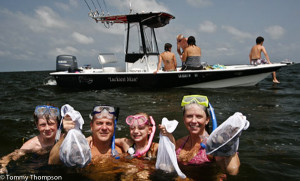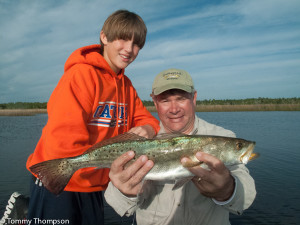Florida’s 2015 Recreational Scallop Season to Close 9/24, But Don’t Despair!
In early June, the “buzz” along Florida’s Nature Coast is all about recreational scalloping. The season usually opens the last Saturday in June, and folks at our Big Bend ports gear up for a busy season. This year’s season was no exception, and limits of bay scallops just kept coming in, almost to the end of the season on September 24. While many consider scalloping to be “fishing”, it’s really more about having a good time with the family and eating some great meals. Our Natural North Florida coastline boasts some of the best scalloping access, with boats leaving from Horseshoe Beach, Steinhatchee, Keaton Beach and St. Marks.

But don’t get the “post-scallop season blues”! There still are plenty of on-the-water activities in our region. I’ve yet to hear a firm explanation as to why the Florida Fish and Wildlife Conservation Commission (FWC) thinks the scallop should stop when it does, but I have my own theory. I think the onset of cooler, end-of-summer water temperatures triggers the spawning activity of scallops and it’s a measure to preserve the scallop population. Also, from a more practical and recreational perspective, vacation season is over and kids are back in school!
Cooling waters and fewer boats on the water mean that the seatrout”bite” that makes our Gulf Coast famous is back. Anglers wishing to catch a limit of 5 trout for dinner most likely will drift the grass flats. Those wishing to catch and release a big, over-slot, 20-inch plus, “gator” trout will fish the shorelines and rocky points. Flats anglers rely on live shrimp or pinfish, as well as artificial baits (D.O.A. shrimp or MirrOlure Catch 200o plugs), while those fishing close to shore will use topwater lures (MirrOlure Top Dogs) to attract the big trout attack.

Here are a few of my favorite spots for trout on our Natural North Florida Gulf Coast:
Yankeetown/Waccasassa: Fish the flats near the Trout Stake, in the middle of Waccasassa Bay, between the Withlacoochee River and Cedar Key.
Cedar Key: Head south from town and fish the flats south of Snake Key. Or, drift the flats between Seahorse Key and North Key.
Suwannee: Head out the McGifff Channel to the northwest and drift near the Red Bank Reef. You might also catch a big Spanish mackerel here!
Horseshoe Beach: You can’t go wrong by heading to the flats between the town of Horseshoe Beach and the Pepperfish Keys. If tides (and your boat’s draft) permit, head inshore towards Drum and Stewart Points.
Steinhatchee: The flats south of marker #1 have been especially active with baitfish all summer, so the the fall bite should be very good. Look for a 3-foot deep “hump” about two miles south of the channel.
Keaton Beach: Head north to the flats off Spring Warrior Creek. Here, trout appreciate live pinfish, pinned under popping corks.
St. Marks: Go (carefully) east from the river’s mouth to the Rock Garden, and start drifting. Here, locals rely on live pinfish and live shrimp.
Panacea: Head out the channel and fish outside the beach at Mashes Sand for trout–and reds!

